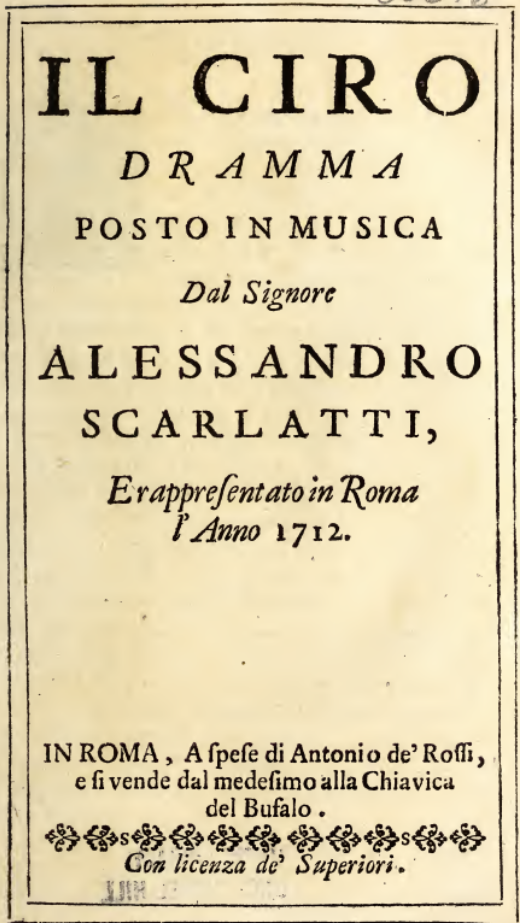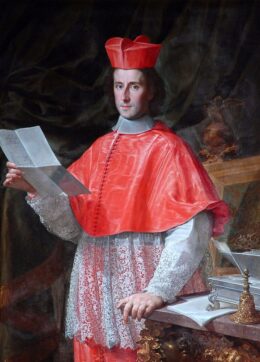
Printed
80 pages
Author(s)
Il Ciro
In 1708, Ottoboni has a magnificent theatre built in his Palace of the Chancellery. Designed by Juvarra and Pellegrini, the theatre comes with one hundred and twenty-seven sceneries. Ottoboni staged Il Costantino pio in his “teatrino ad uso di pupazzi”, at the beginning of the theatrical season in 1710; the following year, he gave Teodosio il Giovane. In 1712, Il Ciro was staged in the theatre. Although this dramma per musica is credited to Ottoboni, its authorship is still contested. According to testimonies, the very expensive puppets were “almost four feet high” and made of cardboard or wood; they closely resembled human actors. They were moved on wooden runners and manipulated from below the stage, using a counterbalance system. The music was composed by Alessandro Scarlatti.
Il Ciro (Cyrus) testifies to the competition that opposed Ottoboni and Pietro Pariati: the latter had borrowed the plot of Costantino in 1711; now, Ottoboni was borrowing his rival’s Ciro. The play was staged at Venice in the Teatro di San Cassano, during the carnival of 1709; the music was composed by Tommaso Albinoni. The two works drew inspiration from Artamène ou le Grand Cyrus (Artamène, or Cyrus the Great), a novel by French author Scudéry, published between 1649 and 1653. In the two plays, Ciro’s identity is only revealed well into the story, to the protagonist himself. Like other plays by Ottoboni, Il Ciro stages two rival monarchs: the tyrant Astiage (Astyages), governed by his tempers, and the good king Ciro (Cyrus), known for being magnanimous. Like the plays before it, Il Ciro uses spectacular scenery and stages splendid ceremonial scenes. The danced scene at the end of the first Act comes after a sacrificial ceremony, just like the scene at the end of the second Act: as Astiage tries to make Arpago (Harpagus) swallow the content of a cup filled with his son’s blood, the sky darkens, the sea becomes turbulent and furies come out of clouds, spoiling the pomp of the dinner, and then dancing. In the third Act, a scene set underground and at night shows the conspirators’ activities. Finally, the play ends with Ciro’s accession, in a transparent palace in the sky, out of which, above the clouds, a great throne emerges—as in Teodosio’s finale.
A lawful king takes his throne back
The shepherd Mitridate took Elcino in and raised him as the brother of his daughter Erenia. Erenia’s love for Arsace, Artemio’s son, and the love of Sandane, Artemio’s daughter, for Elcino are disrupted by the hatred opposing their families. Mitridate tells Erenia that, years before, the King Astiage (Astyages) entrusted Arpago with getting rid of his grandson Ciro (Cyrus) because of a dream. Alone, Erenia remembers that her mother gave birth to a stillborn child, and that his father substituted Elcino for him, caring for him as for his own son. Owing to their love for their respective sisters, Arsace and Elcino reconcile. At the palace, Astiage, suspecting Arpago of not having fulfilled his task, pretends to feel remorse and to wish that Ciro could come back to life. Arpago, Mitridate and Erenia rejoice at this change of heart, and decide to present Elcino to the king: they organise a sacrifice during which Astiage feels drawn to Elcino. To warn him against the tyrant, Mitridate tells Elcino the story of Ciro: the young man decides to take revenge on behalf of the child. When Sandane walks in on him, she confesses her love to him. The act ends with a dance of temple guards.
In the forest, Astiage rushes to Erenia’s rescue, as she is being chased by a wild beast. To take revenge for Elcino’s severity toward Arsace, she tells him that the young man is not her brother, and she promises to bring him the baby blanket with which he was found. Elcino, who came back to his flocks, has grand dreams. He is invited to eat with the king, and Arpago tells him that Ciro is alive. Seeing the baby blanket, Astiage understands who Elcino is, and he appeals to the goddesses for revenge. To avenge himself of Arpago’s poor services, the tyrant has him drink a cup filled with his son’s blood; he also sends Elcino to prison. The sky darkens, the sea becomes turbulent, and furies come out of clouds and begin to dance.
Sandane worries about her lover’s fate. When she sees him in chains, they exchange vows quickly before Elcino is taken back to his dungeon. Erenia, overcome with guilt, tells Sandane about Ciro’s identity, and she declares her Queen. Astiage declares his love to Sandane: she rejects him and asks to die by her husband’s side, which sparks Astiage’s jealousy. The tyrant decides to set Ciro on fire before his wife’s eyes; but the guards have stopped obeying him. In the meantime, Arsace and Arpago have freed Elcino, who is now arriving with the conspirators. He learns about his true identity from Sandane, and takes the tyrant’s place. Erenia confesses to her father that she betrayed him and revealed Ciro’s identity to the King: he forgives her, because she allowed for fates to be accomplished. The play ends with Ciro’s accession: he ascends the throne accompanied by Sandane.
First performance
Palazzo della Cancelleria
Publications and translations
Il Ciro. Roma: Antonio de'Rossi, 1712.
Nicola Badolato, "All'occhio, all'udito ed al pensiero", Gli allestimenti operistici romani di Filippo Juvarra per Pietro Ottoboni e Maria Casimira di Polonia. Torino: Fondazione 1563 per l’Arte e la Cultura della Compagnia di San Paolo, 2016.
Conservation place
Keywords
Theatrical techniques
- Music
- Chorus
- Interlude
- Expository scene
- Account of a dream
- Disguised character (false identity)
- Invisible force
- Hunting scene
- Board meeting
- Monologue
- Procession
- Apparition of demons
- Destruction of set elements
- Thunderbolt
- Release of a prisoner
- Scene in the dark
- Love rivalry
- Scene of recognition
- Change of social status
- Clouds
- Flying machine
- Final wedding
